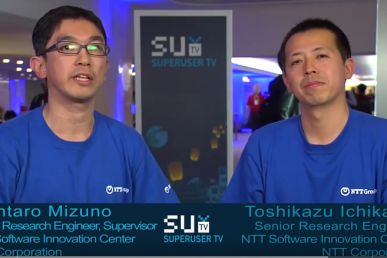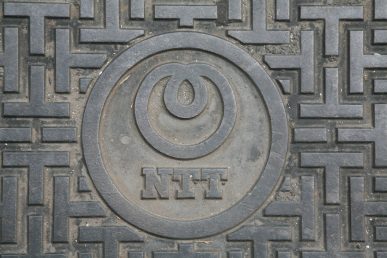We’re spotlighting previous Superuser winners who are on the front lines deploying OpenStack in their organizations to drive business success. These users are taking risks, contributing back to the community and working to secure the success of their organization in today’s software-defined economy.
Nippon Telegraph and Telephone (NTT Group) has various OpenStack deployments in production including large scale public cloud, private cloud for internal services and NFV infrastructure. The following are its major OpenStack deployments.
Note: Abbreviations in brackets are used to describe each deployment throughout this document:
- [Com] NTT Communications provide large scale public cloud service for enterprise, called ECL 2.0
- [Data] NTT Data has two OpenStack deployments: one is for internal application developers and the other is to host its enterprise customers.
- [Resonant] NTT Resonant provides various web based services, including web portal service called “goo,” and has a large internal cloud to host its services.
- [TX] NTT Technocross provides OpenStack support service and has their internal cloud for developers.
- [R&D] NTT Software Innovation Center operates internal R&D Cloud, “XFarm,” for researchers and developers.
What has changed in your OpenStack environment since you won the Superuser Awards?
[Com] We have scaled out to accommodate our customers. We also stabilized our system by fixing bugs to improve our service quality. We also overcame the challenge of OpenStack version up in production.
[Data] We have deployed two large scale OpenStack clusters: one is for internal app development and the other is for external enterprise customers. We have started these two services since 2017 and are still expanding the scale.
[Resonant] We have doubled our virtual machine (VM) numbers since 2015. We are now working on upgrading our environment due to hardware end-of-life since last year. We will be migrating to OpenStack Queens and introducing all-flash storages.
[TX] We have upgraded OpenStack version and the deployment was automated by using Ansible.
[R&D] In 2015 we had two clusters with 15 nodes mainly for evaluation purpose. Now we have three clusters in production with 22 nodes hosting R&D workloads.
What is the current size of your OpenStack environment?
[Com] More than 3,000 compute nodes, 30,000 VMs and 80,000 virtual cores in production.
[Data] Approx. 80 compute nodes / 7,000 VMs / 21,000 virtual cores for internal app development. Approximately 20 compute nodes / 600 VMs / 2,000 virtual cores for external enterprise customers.
[Resonant] Our new deployment has about 60 compute nodes hosting around 3,500 VMs.
[TX] About 20 compute nodes.
[R&D] 22 Compute nodes, 1550 VMs, 8700 vCPUs
What version of OpenStack are you running?
[Com] Mitaka and Queens.
[Data] Newton and Queens.
[Resonant] Our new deployment runs on Queens
[TX] Mitaka and Queens
[R&D] Mitaka and Queens
What open source technologies does your team integrate with OpenStack?
[Com] Ansible, Chef, Docker, Contrail (TungstenFabric), fluentd, Influxdb, Grafana, telegraph, kibana, elasticsearch, filebeat, metricbeat, haproxy, rabbitmq, percona
[Data] Ansible, Docker, Grafana, Prometheus, Kibana, Elasticsearch, Metricbeat, Hinemos, HAproxy , Pacemaker, Corosync, MariaDB and RabbitMQ.
[Resonant] Puppet,Ansible,Docker,Docker-compose, kibana, elasticsearch, fluentd, haproxy, keepalived, CloudFoundry.
[TX] Ansible, haproxy, rabbitmq, percona, kubernetes, docker, gitlab
[R&D] Sheepodg, Ceph
What workloads are you running on OpenStack?
[Com] More than 1,000 enterprise customers including web application, call center, video conference, data processing, NFVs and IoTs.
[Data] More than 1,000 application development projects are using our internal OpenStack environment for develop and testing their apps. Target industries of the projects cover almost all sectors like public, BFSI, manufacturing, healthcare, retail, etc.
For the external customers, OpenStack is mainly used as a platform for various applications in BFSI customers.
[Resonant] 80+ web services with more than 1 Billion page view/month
[TX] Development software and OSS (e.g. K8s, Docker)
[R&D] Our cluster is an IaaS service for R&D employee to conduct research and development and variety of workloads are running.
How big is your OpenStack team?
[Com] About 30 members for OpenStack related development and tier3 engineering.
[Data] We have 10-20 OpenStack engineers.
[Resonant] About 8 OpenStack operators and hundreds of engineers developing applications on OpenStack.
[TX] About 100 engineers including our business partners.
[R&D] About 10 engineers including our business partners are operating OpenStack cluster. We also have around 10 developers contributing to OpenStack including 3 PTLs.
How is your team currently contributing back to the OpenStack project?
[Com] Reporting bug tickets and requests for engineering (RFEs), mainly in Masakari project. Participating community events to present our experience.
[Data] We’re mainly using Red Hat OpenStack so reporting bugs/challenges to Red Hat, which directly contributes to the community. Also, we have about 10 engineers contributing to the OpenStack project (code review, commits, etc.).
[Resonant] Reporting bugs and sending patches through our business partners.
[TX] Reporting bug tickets.
[R&D] Contributing in various OpenStack projects including Tacker, Nova/Placement, Swift and Masakari. We also report bugs and upstream patches.
Also NTT Group is actively contributing to regional OpenStack community activities including organizing meetups, OpenStack Days event, and running slack groups for operators.
What kind of challenges has your team overcome using OpenStack?
[Com] We increased the capability and agility to integrate our infrastructure with our customer system through OpenStack APIs.
[Data] We have successfully reduced the cost of infrastructure for many application development projects by consolidating their platforms into one. Also, we have successfully provided agility and flexibility to BFSI customers for their digital transformation.
[Resonant] We have managed to reduce server procurement cost by having our infrastructure team conduct collective procurement and assign resources appropriately, instead of having each development team to purchase servers separately.
[TX] Compute resources for developers can be prepared on an on-demand basis.
[R&D] We managed to reduce server cost by having our internal IaaS and at the same time, we were able to advance our capabilities in operating open source cloud, which we share among other group companies.
- Exploring the Open Infrastructure Blueprint: Huawei Dual Engine - September 25, 2024
- Open Infrastructure Blueprint: Atmosphere Deep Dive - September 18, 2024
- Datacomm’s Success Story: Launching A New Data Center Seamlessly With FishOS - September 12, 2024

)










